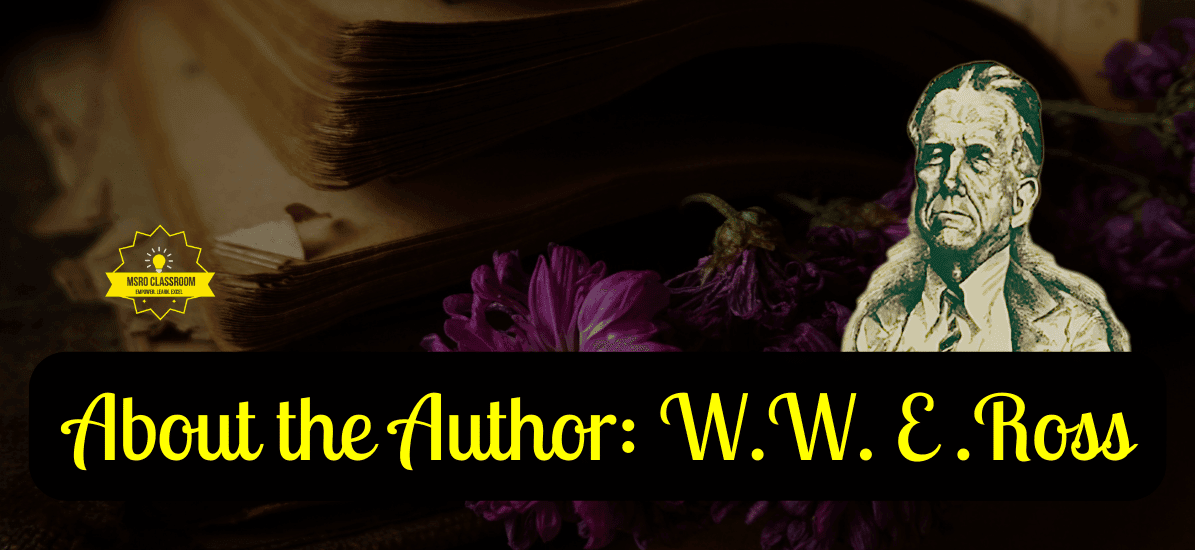William Wrightson Eustace Ross (1894-1966) , known as W. W. E. Ross, holds a unique place in Canadian literature as an exemplary practitioner of Imagist poetry. His literary career, though relatively brief in its Imagist phase, left an indelible mark on the landscape of Canadian poetry. Born in Peterborough, Ontario, in 1894, Ross’s journey from a small-town boy to a celebrated poet and geophysicist is as fascinating as it is inspiring.
About the Poet: W.W.E. Ross
Table of Contents
More Elusive Authors: Markus Natten, A. R. Barton
Also Read: Class 9 – ‘The Snake Trying‘ by W.W.E. Ross
The information on W.W.E. Ross was gathered from various sources, including literary journals and published correspondence. MSRO CLASSROOM has meticulously compiled and verified the details presented in this article to ensure accuracy and provide a comprehensive view of W.W.E. Ross literary journey.
Early Life and Education:
Ross spent his formative years in Pembroke, Ontario, before starting his academic journey at the University of Toronto, where he pursued a Bachelor of Science degree. His education was not confined to the classroom; he worked on geological surveys in northern Ontario during the summers. These regions, later immortalised by the Group of Seven’s paintings, undoubtedly influenced Ross’s perception of the natural world and found reflection in his poetic imagery.
Military Service and Career as a Geophysicist:
With the outbreak of World War I, Ross served in the Canadian Expeditionary Force, an experience that, while not directly documented in his poetry, likely shaped his worldview and sensibilities. After the war, Ross embarked on a career as a geophysicist at the Dominion Magnetic Observatory in Agincourt, Ontario, in 1924. This dual engagement with science and poetry underscores the depth of his intellectual pursuits and the breadth of his curiosity.
Literary Beginnings: W.W.E. Ross
Ross began writing poetry in the early 1920s, and his work quickly garnered attention. His poems were accepted for publication in prestigious journals such as The Dial, edited by Marianne Moore, and Poetry. This early success was a testament to his distinctive voice and the resonance of his imagery.
Contribution to Imagism:
Imagism, a literary movement that emphasised clarity, precision, and economy of language, found a perfect adherent in Ross. His volume “Laconics,” published in 1930, is a landmark in Canadian poetry. This collection, characterised by its brevity and vivid imagery, exemplifies the core principles of Imagism. Ross’s work in this collection is often noted for its meticulous attention to detail and the ability to capture complex emotions and scenes with minimal words.
One of the hallmarks of Ross’s Imagist poetry is its focus on natural landscapes, perhaps influenced by his background in geological surveys. His poems often present scenes of stark beauty and evoke a sense of place with a clarity that is both startling and profound. For instance, his poems might describe a solitary tree against a winter sky or the subtle interplay of light and shadow on a forest floor, each image rendered with a precision that invites readers to see the world through his eyes.
The Shift to Sonnets:
In 1932, Ross published ‘Sonnets’, a collection that, while not as celebrated as ‘Laconics’, still interests literary scholars. These sonnets often mirror the subject matter and imagery of his earlier Imagist poems, bridging his adherence to the strict forms of classical poetry and his more experimental endeavours. The sonnets reflect a transitional phase in Ross’s poetic journey, showcasing his versatility and willingness to explore different poetic forms.
Translations and Prose Poems:
The 1930s also saw Ross engaging in translation work, notably of Max Jacob, the experimental French poet. This endeavour introduced Canadian readers to Jacob’s avant-garde poetry and influenced Ross’s style. His translations are praised for their fidelity to the original texts while capturing Jacob’s work’s spirit and innovation.
Moreover, Ross penned some of the earliest prose poems in English in Canada. These prose poems illustrate his experimental approach and desire to push conventional poetic forms’ boundaries. They offer a glimpse into Ross’s creative mind, revealing his ability to blend poetic elements with prose to create evocative and thought-provoking pieces.
Correspondence and Legacy:
Ross’s correspondence with contemporaries such as A.J.M. Smith and Ralph Gustafson provides valuable insights into his thoughts on poetry and his creative process. These letters, now published, serve as a testament to his intellectual engagement with the literary movements of his time and his contributions to Canadian literature.
The posthumous publication of “Shapes & Sounds: Poems of W.W.E. Ross” in 1968, edited by Raymond Souster and John Robert Colombo, is a comprehensive collection that celebrates Ross’s literary achievements. This anthology has played a crucial role in cementing Ross’s legacy as a pioneer of Imagist poetry in Canada.
Conclusion:
W.W.E. Ross’s contribution to Canadian literature is significant not only for his pioneering work in Imagism but also for his explorations of different poetic forms and his translations of experimental French poetry. His ability to capture the essence of a moment or a scene with precision and clarity remains a defining feature of his work. Though his career as an Imagist poet was brief, his influence endures, inspiring generations of poets to embrace clarity, precision, and the power of imagery.
Ross’s life, marked by his dual passions for science and poetry, reminds us of the richness of exploring multiple disciplines. His legacy is that of a true pioneer whose work continues to resonate in Canadian poetry.

